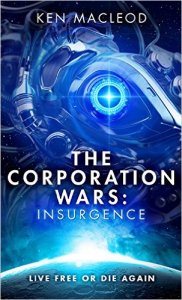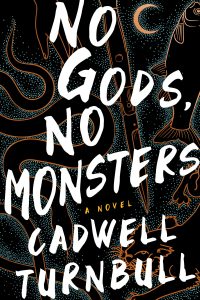Paul Di Filippo reviews Ken MacLeod
The Corporation Wars: Dissidence, by Ken MacLeod (Orbit 978-0316363655, $9.99, 384pp, mass market paperback) US edition November 29 2016
The Corporation Wars: Insurgence, by Ken MacLeod (Orbit 978-0316363693, $9.99, 384pp, mass market paperback) December 20, 2016
 I just missed celebrating the twentieth anniversary of Ken MacLeod’s debut, the publication of The Star Fraction in 1995. I make out that he’s issued nearly that many books in the two decades since, certainly an admirable record. And he’s maintained a good balance between series and singletons. But most importantly, he has represented a unique voice in the field, blending deep, fresh thoughts on political science and economics with rousing adventures full of solid speculations. His nearest comrades might by Charles Stross and China Miéville, but neither are exact counterparts. Despite his perceived radicalism, in some warped, non-intuitive way, when one puts aside his antithetical worldview, he might almost be John W. Campbell’s dream writer, a kind of ultra-progressive, postmodern Mack Reynolds or Christopher Anvil or Eric Frank Russell with better literary chops.
I just missed celebrating the twentieth anniversary of Ken MacLeod’s debut, the publication of The Star Fraction in 1995. I make out that he’s issued nearly that many books in the two decades since, certainly an admirable record. And he’s maintained a good balance between series and singletons. But most importantly, he has represented a unique voice in the field, blending deep, fresh thoughts on political science and economics with rousing adventures full of solid speculations. His nearest comrades might by Charles Stross and China Miéville, but neither are exact counterparts. Despite his perceived radicalism, in some warped, non-intuitive way, when one puts aside his antithetical worldview, he might almost be John W. Campbell’s dream writer, a kind of ultra-progressive, postmodern Mack Reynolds or Christopher Anvil or Eric Frank Russell with better literary chops.
Currently MacLeod is in the middle of a saga, The Corporation Wars, with the third book, The Corporation Wars: Emergence, due in September 2017. But we can gear up for that conclusion by having a look at the first two.
The overarching designation of the series—“The Corporation Wars”—has an echt-cyberpunk air about it. But the series, while dealing with some of the core tropes of that sub-genre, is really more New Space Opera with a Greg Egan-ish overlay of metaphysics.
We open with a quick portrait of our familiar planet circa 2200, when the whole world seems at war (in a postmodern manner reminiscent of the conflicts in New Model Army by Adam Roberts.) One of the warriors is dubbed Carlos the Terrorist. We watch him die, and then cut to “exomoon SH-17,” where a construction robot named Seba has just spontaneously attained autonomy and full self-awareness, along with some fellow “freebots.”
Our next venue is a virtual-reality simulacrum of the planet that hosts exomoon SH-17, inside which silicon existence Carlos—in digital form—has just been reincarnated. He gets an introductory lecture from his handler Nicole, who informs him that the time is now the 32nd century—1000 years after his death—and that the VR world he inhabits is platformed in a computer orbiting around an exoplanet some 24 light-years from Earth. Everything in this star system—including Seba and posse and any other humans—has been built with local materials from the instructions contained in a starwisp probe. With no practical communications possible with Earth—ruled by a system called the Direction—the agenda at the colony site is being carried out by a local AI.
That executive agent was the one who dictated that Carlos and five other dead human fighters should be revived, trained, and sent out to subdue the rogue freebots. After they harmonize into a team inside the virtual reality, the six ghost soldiers will be instantiated inside weaponized physical ships (has that novum by Anne McCaffrey ever been acknowledged as the seminal trope it is?) and launched against the freebots. After any real-world “deaths,” the ghosts get rebooted again inside the VR world.
What follows is a kind of action-packed Dirty Dozen or Suicide Squad scenario, but with plenty of speculative side-paths, such as the way in which the freebots organize themselves, and the true nature of the colonizing expedition. The major impact on this latter thread stems from Carlos meeting a figure named Shaw inside the VR. Shaw claims to have been alive for the whole thousand years since the era of Carlos, and he also maintains that the real setup is the reverse of what Nicole has said. The alien planet VR is physical, and the fighting with the robots is the actual VR exercise!
By the novel’s end, Carlos has broken off with the Direction and gone rogue himself, and it appears that the old antagonists of his era—the Rax and the Axle—are still active and vying for supremacy.
 The second book introduces several new characters, notably a ghost soldier named Harold Isaac Newton and a robot named Baser; these two unlikely souls will become allies and friends. And because Carlos is now separate from his old comrades, the once-bipartite narration (switching from robots to humans and back) is now tripartite: two camps of humans and the robots.
The second book introduces several new characters, notably a ghost soldier named Harold Isaac Newton and a robot named Baser; these two unlikely souls will become allies and friends. And because Carlos is now separate from his old comrades, the once-bipartite narration (switching from robots to humans and back) is now tripartite: two camps of humans and the robots.
Where Carlos has ended up after fleeing is in another VR environment, this one hosted by the entity known as Arcane Disputes. His old boss was Locke Provisos. Arcane seems to represent the current-day incarnation of the Axle, while Locke seems infested by the Rax. Being a loyal Axle man from way back, naturally Carlos wants in with Arcane. There he finds another old comrade, Jax, and he begins to learn more about all the players and their motives in this hyper-complicated battleground.
There’s lots of action in this second installment, including thrilling space battles and VR weirdness. There’s plenty of discussion along lines of thought old and new. For the first time we begin to learn why unleashed AI has not resulted in a Singularity. And there’s further speculation about what the conditions are back in the home solar system, and whether the Direction favors Axle or Rax. But mainly, despite some new developments, this second volume feels more like an extension of the first book or a holding action before big doings in the third upcoming book. This middle-volume semi-stasis is all too familiar.
MacLeod does many astonishing things here. He creates viable, believable multiplex interactions among so many different sets of characters, human and robot. His detailing of the non-human way of thinking and speaking employed by the freebots is fun and exemplary. (He graciously cites Brian Aldiss’s work as an inspiration.) The philosophies and creeds and belief systems of the humans are interesting, engaging and morally deep. He shows a keen hand with action sequences. And there is a generous amount of humor to leaven the otherwise dire and deadly consequences of the multi-front war.
He does indulge in plenty of omniscient info-dumps, such as this:
Sharing conversations and trains of argument is an easy matter for robots. While their consciousness doesn’t exactly run on machine code, there’s a much closer connection between the underlying process of communication and of thought than there is in organic brains. Keeping their thoughts between themselves, likewise: it would have been possible for the Arcane Disputes fighters in the shelter to decrypt and interpret the interactions in the freebots’ common mental workspace, but it would have taken them an unfeasible length of time, or far better computing resources than it took to run their own minds, let alone any of their onboard peripheral processors.
You need to be onboard with these asides that do break up the flow of action. But such passages have always been a “feature not a bug” in SF.
Altogether, it seems to me that MacLeod has deliberately pared back some of the more abstruse game-playing of his earlier books to fashion a series that is more—well, not “superficial,” but just fan-friendly. It’s rather as if he had signed on to write an episode of James S. A. Corey’s The Expanse instead of producing a “typical” MacLeod novel as of yore.
But MacLeod’s immense talents and verve survive and conquer any faint wisps of commercialism. He steps more lightly, but still along those same roads only he knows so well.




